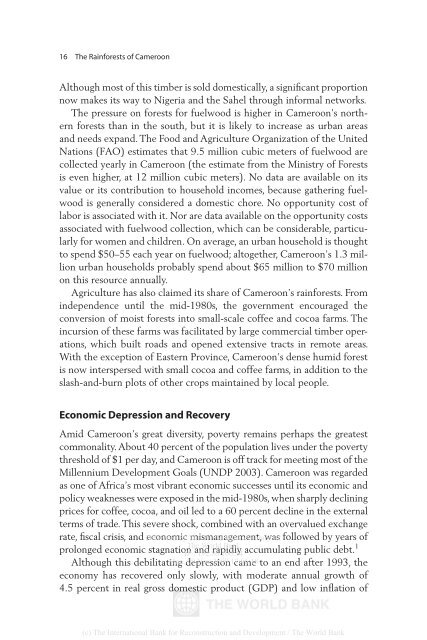The Rainforests of Cameroon - PROFOR
The Rainforests of Cameroon - PROFOR
The Rainforests of Cameroon - PROFOR
- No tags were found...
Create successful ePaper yourself
Turn your PDF publications into a flip-book with our unique Google optimized e-Paper software.
16 <strong>The</strong> <strong>Rainforests</strong> <strong>of</strong> <strong>Cameroon</strong>Although most <strong>of</strong> this timber is sold domestically, a significant proportionnow makes its way to Nigeria and the Sahel through informal networks.<strong>The</strong> pressure on forests for fuelwood is higher in <strong>Cameroon</strong>’s northernforests than in the south, but it is likely to increase as urban areasand needs expand. <strong>The</strong> Food and Agriculture Organization <strong>of</strong> the UnitedNations (FAO) estimates that 9.5 million cubic meters <strong>of</strong> fuelwood arecollected yearly in <strong>Cameroon</strong> (the estimate from the Ministry <strong>of</strong> Forestsis even higher, at 12 million cubic meters). No data are available on itsvalue or its contribution to household incomes, because gathering fuelwoodis generally considered a domestic chore. No opportunity cost <strong>of</strong>labor is associated with it. Nor are data available on the opportunity costsassociated with fuelwood collection, which can be considerable, particularlyfor women and children. On average, an urban household is thoughtto spend $50–55 each year on fuelwood; altogether, <strong>Cameroon</strong>’s 1.3 millionurban households probably spend about $65 million to $70 millionon this resource annually.Agriculture has also claimed its share <strong>of</strong> <strong>Cameroon</strong>’s rainforests. Fromindependence until the mid-1980s, the government encouraged theconversion <strong>of</strong> moist forests into small-scale c<strong>of</strong>fee and cocoa farms. <strong>The</strong>incursion <strong>of</strong> these farms was facilitated by large commercial timber operations,which built roads and opened extensive tracts in remote areas.With the exception <strong>of</strong> Eastern Province, <strong>Cameroon</strong>’s dense humid forestis now interspersed with small cocoa and c<strong>of</strong>fee farms, in addition to theslash-and-burn plots <strong>of</strong> other crops maintained by local people.Economic Depression and RecoveryAmid <strong>Cameroon</strong>’s great diversity, poverty remains perhaps the greatestcommonality. About 40 percent <strong>of</strong> the population lives under the povertythreshold <strong>of</strong> $1 per day, and <strong>Cameroon</strong> is <strong>of</strong>f track for meeting most <strong>of</strong> theMillennium Development Goals (UNDP 2003). <strong>Cameroon</strong> was regardedas one <strong>of</strong> Africa’s most vibrant economic successes until its economic andpolicy weaknesses were exposed in the mid-1980s, when sharply decliningprices for c<strong>of</strong>fee, cocoa, and oil led to a 60 percent decline in the externalterms <strong>of</strong> trade. This severe shock, combined with an overvalued exchangerate, fiscal crisis, and Delivered economic by <strong>The</strong> mismanagement, World Bank e-library was to: followed by years <strong>of</strong><strong>The</strong> World Bankprolonged economic stagnation IP : and 192.86.100.34 rapidly accumulating public debt. 1Although this debilitating Mon, depression 09 Nov 2009 17:06:18 came to an end after 1993, theeconomy has recovered only slowly, with moderate annual growth <strong>of</strong>4.5 percent in real gross domestic product (GDP) and low inflation <strong>of</strong>(c) <strong>The</strong> International Bank for Reconstruction and Development / <strong>The</strong> World Bank
















